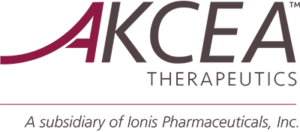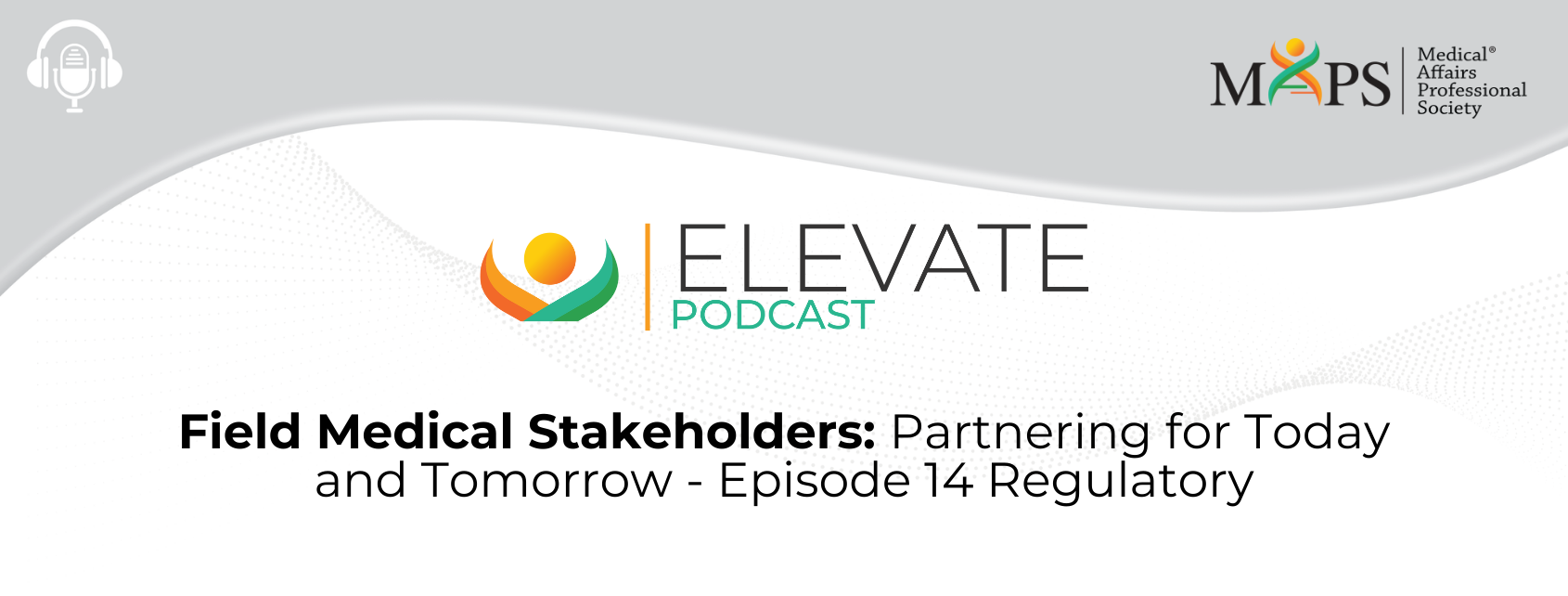Partnering for Today and Tomorrow – Episode 14 Regulatory
Link will be added when available

Objectives
At the end of this series of podcasts, the participant should be able to:
- Discuss the functions and activities of key internal partners
- Identify potential areas for compliant collaboration by MSLs with key internal partners

MODERATOR: Kathryn Gann, PhD

INTERVIEWER: Robert Groebel


INTERVIEWEE: Jamie MacPherson

Following is an automated transcription provided by otter.ai. Please excuse inaccuracies.
Kathryn Gann 0:00
Welcome to the medical affairs professional society field medical focus area working groups podcast series, entitled field medical stakeholders Partnering for today and tomorrow. In this 14th podcast, we will be discussing Regulatory Affairs. I’m Katherine Gan, and I’m a member of the field medical focus area Working Group. I’ll be the moderator for this podcast. Currently, I’m an independent consultant in medical affairs, having spent my 30 year career as an MSL and MSL manager, and an MSL trainer. Our legal disclaimer is as follows. The views expressed in this recording are those of the individuals and do not necessarily reflect on the opinions of maps, or the companies with which they are affiliated. This presentation is for informational purposes only, and is not intended as legal or regulatory advice. We encourage you to engage in conversation about partnering with field medical stakeholders with other maps members by the community portal on the maps website. Simply log in with the email address associated with your maps account and click on the discussion tab. Then scroll down to field medical to post a question or review previous postings. The objectives for this series of podcasts are that at the end of this series, the participant will be able to one discuss the functions and activities of key internal stakeholders and to identify potential areas for compliant collaboration by MSL with key internal stakeholders. I’d like to thank today’s panelists for sharing their subject matter expertise with the max membership. speaking today are Robert global vice president global medical strategy at monocle. And Roberts going to be our interviewer. And Jamie MacPherson, Vice President, head of regulatory affairs and quality assurance at akcea therapeutics. Jamie will be our interviewee. Robert, as I turn this over to you, could you just give us a little background on yourself and then kick us off, please.
Robert Groebel 2:03
Thanks, Kathy. Thanks very much for having me again. Yes, Robert global. I’m the Vice President of strategy for monocle. We’re a cloud based software as a service organization that’s focused on supporting medical affairs through data and insights. I’ve been in the healthcare industry for about 25 years now with the bulk of my career spent in medical and commercial roles at both berenguer Ingelheim and scheier. With that, Jamie, could you introduce yourself?
Jamie MacPherson 2:31
Sure, thank you. My name is Jamie MacPherson. Currently at ESEA therapeutics, I’m actually a pharmacy by training, I obtained my farm D from Northeastern University and had the opportunity to get exposed to Regulatory Affairs during my co op opportunity there. I spent about 20 years of experience, right in regulatory in my first career opportunity, ranging from small companies to large biotechs in the in the Boston area.
Robert Groebel 3:05
That’s great. Thanks very much. So. So as we think about the partnership element of our podcast series, can you talk to us about what your department is primarily responsible for, and how it might differ from your experience at a larger pharmaceutical company, if that if there is a difference that exists?
Jamie MacPherson 3:25
Sure. So I often I mean, our ultimate goal in the regulatory affair department is to partner with internal stakeholders, as well as external, external stakeholders. And our main focus, probably just like many other functions in the, in the pharmaceutical arena, is to make sure that we’re providing therapies to patients in the most, you know, efficient, yet in a compliant manner. So, internally, you know, we provide guidance to many of our stakeholders throughout the lifecycle of the product. And regulatory is pretty different in that there’s, there’s regulatory aspects from, you know, early development way into, you know, post approval, and that’s one of the things that, you know, is attractive. And, and we I also described regulatory as the main contact with with regulators, the face of the company to regulators, so we work externally and partner with regulators, you know, to influence their decision making, as as they’re reviewing drugs or therapies. And I think, you know, smaller company, you sort of have to wear those several different hats within within regulatory as opposed to in a larger biotech. You know, a lot of the different niches within regulatory are sort of subset it out. So, you know, you may have One department of just reviewing advertising and promotion, you may have one department reviewing labeling, whereas in a small company environment, you sort of have to wear those multiple hats.
Robert Groebel 5:12
So is it safe to assume you have a broad group of internal stakeholders you’re working with?
Jamie MacPherson 5:18
That’s right. Some of our key stakeholders, include folks in clinical development, include medical affairs, include manufacturing, and commercial, ultimately, those are some of the key, I’d say, internal stakeholders that we partner with.
Robert Groebel 5:38
Now, Jamie, when you introduce yourself, you also said quality assurance, is that an additive portion of the way that the regulatory group operates as a collective? Or do you see that as something that is kind of standard in the industry?
Jamie MacPherson 5:53
Yeah, it’s, it’s, I think, it’s also sort of a, how the company is set up, getting back to your earlier question, and a smaller company environment, you know, you, you may have a couple of different groups, you know, that fall under one leader, I really do view quality assurance separate from from regulatory, you know, quality assurances is ensuring a quality product, you know, is is released and getting to patients, where, you know, regulatory, I see is a little bit different at Expedia. You know, because of the small company environment, I lead both groups, but in a large pharma group, you know, that quality assurance is typically separate from from Regulatory Affairs.
Robert Groebel 6:39
And that’s kind of new, that’s kind of new for me. So when you think about the quality assurance side of this, were there elements of your regulatory experience that made it appropriate? Or made it logical to bring those two groups together? You know, beyond the size of your, your total organization?
Jamie MacPherson 6:57
Sure, sure. So there’s a lot of commonalities as as you might imagine, I mean, you know, the specifications or how the product is tested, you know, certainly kind of crosses the line between what’s registered in your dossier. And, versus quality, who’s sort of enforcing those, those specifications? Right. So it sort of crosses the line a little bit, but but there are, you know, differences, whereas, you know, regulatory professionals don’t release, you know, the products, there’s, you know, a caliber of person with this particular, you know, particular expertise, that, you know, releasing products, I had the fortune in my career to have spent a lot of time in the, in the compliance area, within the CMC group. And so that sort of, to me touched a little bit, whereas, you know, quality is involved in infections, you know, responding to inspection observations, so they deal with a health authorities, you know, to a certain degree. So, so some commonalities, but but a little bit, you know, of difference.
Robert Groebel 8:11
And forgive me, is there is exia, a global company, or does it have just a US footprint?
Jamie MacPherson 8:19
Yeah. So we were global, we had a few announcements recently, and really are sort of focusing on on the North America footprint. But we were across Europe, Canada, and the US at one time, we have partnerships, also, that, you know, our reach is, you know, we’ve worked through the partners in like Latin America, for instance, on, you know, on a more global scale.
Robert Groebel 8:52
That’s interesting. Now, does does does working as a partner, have any? Are there any subtleties to that? When you look at, even with your mention of compliance, and that quality and regulatory? How do you work effectively with a partner as opposed to, let’s say, a corporate entity that might have a similar or shared point of view or a similar stewardship, shared set of rules and regulations?
Jamie MacPherson 9:20
Yeah. So it’s a very interesting dynamic of working through a partner for the reasons that that you highlighted, you know, certain, you know, certainly we’re all under, you know, the same objective of, of trying to get products, you know, therapies to patients in need. There is that nuance of partnerships in that, you know, companies tend to have their own, let’s say, motivations, I guess, or, you know, the desires behind the scenes, but, you know, it’s, we’re the product experts, and we really do feel that way, you know, on our side and, you know, we try work together with the partners as best as we can, you know, to educate and work together with them on on dossiers and marketing applications and commercializing, you know, the products. So, it I think it all comes down to relationships, probably, you know, what, which also makes the world go round is, you know, building that relationship from a partner perspective. And sometimes, you know, it does, you know, different motivations, you know, kind of, you know, have to be escalated to we call it a JSC, and ultimately be be decided, but I haven’t encountered any, you know, kind of, you know, compliance issue, if you will, on on either side, it’s, it’s sort of just, you know, what the market dynamic might be, and how that might drive strategy.
Robert Groebel 10:53
And thank goodness for well established joint steering committee, I worked through many of those in my day. So that’s really great. So that might be an obvious question for somebody who’s been in the industry as long as you and I both have, but what’s your what’s your understanding of the role of the medical science liaison? So, I
Jamie MacPherson 11:12
mean, I really view the MSL as as you know, customer facing external facing, you know, representative of the company from a from a medical side, right. So things from you know, customer facing things from the medical community things, you know, interfaces with the professional organizations or anyone interested in, in sort of the, you know, medical nature of our products, you know, that I view the MSL as, as the face, you know, for them?
Robert Groebel 11:46
And are there are there ways that are clear opportunities for collaboration between regulatory and quality assurance with the MSL?
Jamie MacPherson 11:56
Certainly, so, you know, I often interact with Ms cells on external communications or, you know, presentations to different audiences, and, and it’s collaborating with them to, you know, ensure that, you know, obviously, the information is accurate, and truthful. The another way we interact is, you know, requests for ISP, or investigator sponsored studies, you know, them coming through the, you know, review committee for, you know, approval and insight for if there’s a medical information requests, you know, making sure and collaborating with the MSL on the right response, and making sure that it, you know, answers the question that that, you know, the customer is asking.
Robert Groebel 12:51
Okay, that’s great. That’s great. And, you know, one of the things that we we’ve always seen as kind of the currency of the MSL are those insights they bring back from the, you know, as the customer facing or the field facing role, scientifically, the value of an MSL insight, are there ways that they can improve them or enhance the insights they’re bringing back that have a very clear focus on driving regulatory value?
Jamie MacPherson 13:20
Certainly, one of the examples that comes to my head is, you know, feedback on our label, or, you know, feedback on our instructions for us, right. So if if there’s a concept that’s not clear in the label, or a concept that’s not clear, and instructions for use, as they’re dealing with nurses are professionals, that certainly feedback, you know, we in regulatory want to want to hear, you know, because we can do something about that. And we want to make the most of it for our, you know, as you mentioned, external customers. So, I and I, I definitely love to hear tidbits from what’s going on, you know, what’s going on in the customers mind or the medical community, about our products, you know, and feeding that back in, it helps as we think about Lifecycle Management. You know, like I said, it helps them in how we’re thinking about, you know, external communications, our usppi our advertising, promotion materials. So there’s there’s definitely things we can you know, get from from external customers and through the MSL that I would definitely appreciate from from the regulatory side.
Robert Groebel 14:31
That’s, that’s terrific. That’s really that’s really terrific. And, you know, all the time I’ve spent talking to field medical teams and talking about insights, I’m not sure I’ve ever really focused in on the actual physical instructions that are delivered out to to the caregiver or to the support staff that are helping a patient understand how to exact you know, treatment and and that type of that type of insight really does speak To patient outcomes, quality of life satisfaction, so that I think is a, that’s a that’s a real gem from these. I mean, Kathy has invited me to do this a couple of times. But I think that’s just some really terrific feedback. So thanks very much for that. Jamie. Kathy, I’ll turn it back over to you.
Kathryn Gann 15:18
Well, thank you, Robert. And Jamie, and yeah, Robert, I agree that was a gem for me, also, the feedback on the label or the patient instructions for use? I never thought about that, actually, from a regulatory point of view. So, Jamie, you’ve certainly not only educated our audience, you’ve educated Robert and me to
Jamie MacPherson 15:41
no problem. I mean, it definitely helps with, you know, even product complaints. You know, if if customers are continually struggling with one piece, and we’re getting feedback from a product complaint perspective, you know, that’s definitely something we can be proactive and correct. So that, you know, there’s not that negative connotation around our products.
Kathryn Gann 16:02
Great, and what a great use of the insights that MSL is put in. So in line with our learning objectives, I think participants should now have a better understanding of the role and function of regulatory affairs, and its impact. And well roll with across the lifecycle that guidance throughout the lifecycle from very early on to post marketing. And then also, as we’ve just been discussing, how msls may compliantly interact with Regulatory Affairs and just what a great tidbit that was, Jamie. So thank you again for that. So this has been the 14th podcast in a series on the topic of field medical stakeholders Partnering for today and tomorrow. If you’re a maps member, thank you for supporting maps. If you’re not yet a maps member and would like access to additional resources in this area, please visit the maps website to explore joining. And that website is medical affairs.org forward slash membership. This concludes the podcast





